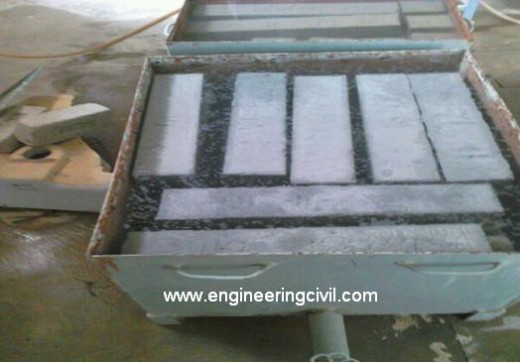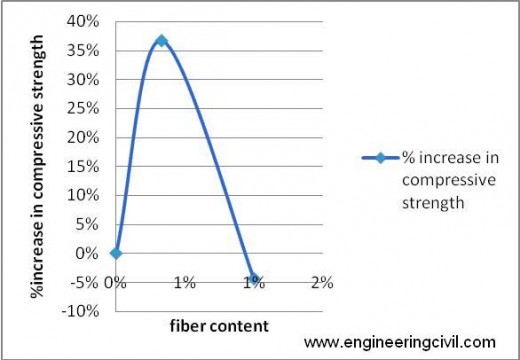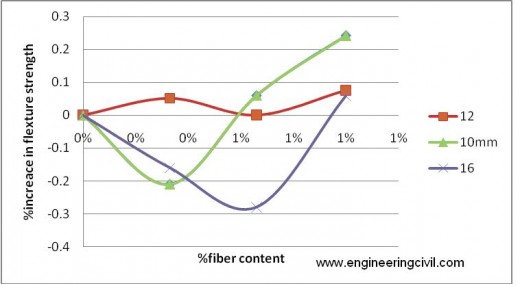ABSTRACT
plain concrete possess very low tensile strength, limited ductility and little resistance to cracking .Internal micro cracks are inherently present in concrete and its poor tensile strength is due to propagation of such micro cracks. Fibres when added in certain percentage in the concrete improve the strain properties well as crack resistance, ductility, as flexure strength and toughness. Mainly the studies and research in fiber reinforced concrete has been devoted to steel fibers. In recent times, glass fibres have also become available, which are free from corrosion problem associated with steel fibres. The present paper outlines the experimental investigation conducts on the use of glass fibres with structural concrete. CEM-FILL anti crack, high dispersion, alkali resistance glass fibre of diameter 14 micron, having an aspect ratio 857 was employed in percentages , varying from 0.33 to1 percentage by weight in concrete and the properties of this FRC (fibre reinforced concrete) like compressive strength, flexure strength, toughness, modulus of elasticity were studied.
1. INTRODUCTION
Concrete is the most widely used construction material has several desirable properties like high compressive strength, stiffness and durability under usual environmental factors. At the same time concrete is brittle and weak in tension. Plain concrete has two deficiencies, low tensile strength and a low strain at fracture. These shortcomings are generally overcome by reinforcing concrete.
Normally reinforcement consists of continuous deformed steel bars or pre-stressing tendons. The advantage of reinforcing and pre-stressing technology utilizing steel reinforcement as high tensile steel wires have helped in overcoming the incapacity of concrete in tension but the ductility magnitude of compressive strength.Fibre reinforced concrete (FRC) is a concrete made primarily of hydraulic cements, aggregates and discrete reinforcing fibres. FRC is a relatively new material. This is a composite material consisting of a matrix containing a random distribution or dispersion of small fibres, either natural or artificial, having a high tensile strength. Due to the presence of these uniformly dispersed fibres, the cracking strength of concrete is increased and the fibres acting as crack arresters.
EXPERIMENTAL PROGRAMME
The details of materials used in the present programme are as follows.
Cement
Portland pozzolona cement of 43 Grade available in local market has been used in the investigation. The cement used has been tested and found to be conforming to the IS 1489 specifications. The specific gravity was 3.15.
Coarse aggregate
Crushed angular aggregates from a local source were used as coarse aggregate.
Fine aggregate
Zone 3rd sand was used as fine aggregate. The specific gravity was determined and was found as 2.74.
Glass fiber
The glass fibers used are of Cem-FIL Anti-Crack HD with modulus of elasticity 72 GPA, Filament diameter 14 microns, specific gravity 2.68, length 12 mm (Properties as obtained through the manufacturer are shown on table1).
Water
Locally available portable water is used.
Test specimens
Test specimens consisting of 100×100×100 mm cubes and 100×100×500 mm beams were cast as shown in figure 1 and tested as per IS: 516 and 1199.
CONCRETE MIX
The M20 grade in quantities used in per cubic meter are shown in table 2.the water cement has been fixed.
MIXING
After mixing in fully pan mixer, the mix was cast in moulds for each % of fiber sufficient no of cubes (table 3) and flexure beams (table 4) were cast for testing at the ages of 28 days.
Table 1
| Table1. Properties Of Glass Fiber Cem-Fil Anti Crack HD. | |
|
AR Glass |
|
2.68 |
|
72 |
|
1700 |
|
14 |
|
12 |
|
235 |
| (million/Kg) | |
Table2
| s.no. | material | quantity per m3 in kg |
| 1 | cement 33 grade ppc | 350 |
| 2 | fine aggregate | 873 |
| 3 | coarse aggregate (20mm) | 444 |
| 4 | coarse aggregate (10mm) | 666 |
| 5 | Water | 140 |
| 6 | Fiber | 0-1% by total weight of mix |
| 7 | super plasticizer | 5 |
Table 3
| Number of beam specimen cast using different fiber content and different area of steel | |||||
| %fiber |
0% |
0.33% |
0.67% |
1% |
description |
| diameter in mm | |||||
|
10 |
4 |
4 |
4 |
4 |
Under reinforced |
|
12 |
4 |
4 |
4 |
4 |
Under reinforced |
|
16 |
4 |
4 |
4 |
4 |
Over reinforced |

Table 4:-Number Of Cube Specimen Cast Using Different % Of Fiber Content
| %fiber |
0% |
0.33% |
0.67% |
1% |
| number of cube |
8 |
8 |
8 |
8 |
RESULTS AND DISCUSSION
1. Compressive Strength:-
The observation from our results shows that the increase in compressive strength is up to 37% in case of adding 0.33% fibre content in comparison of conventional concrete. Figure2 and Table5 shows the variation in compressive strength by adding fibre.
Table 5:-Variation Between Percentage Increase In Compressive Strength
| fiber content | % increase in compressive strength |
|
0% |
0% |
|
0.33% |
36.67% |
|
1% |
-4.40% |

2. Flexure Strength
The percentage increase in flexure strength of glass fibre is observed to be 130%when compared with ordinary plain concrete
The percentage increase in flexure strength of glass fibre reinforced concrete using fibre content 0.33% and 1.25% steel (12mm reinforcement bar) is observed to be 150% when compared with glass fibre concrete(without reinforcement).
Table 6:- Compressive and Flexure Strength For Different Fiber Content at 28 days
| %fiber | compressive strength in N/mm2 | flexure strength in N/mm2 | |||
| without reinforcement | 10mm 12mm | 16mm | |||
|
0 |
30 |
3.19 |
14.85 |
17.325 |
24.075 |
|
0.33 |
41 |
7.31 |
11.7 |
18.225 |
20.25 |
|
0.67 |
30 |
7.59 |
15.7 |
17.325 |
17.325 |
|
1 |
28.67 |
7.07 |
18.45 |
18.65 |
25.5 |
Table 7:- Percentage Increase of Compressive, Flexure Strength of Glass Fiber Concrete In Comparison With Ordinary Concrete Mixes at 28 days
| %fiber | compressive strength | flexure strength | |||
| without reinforcement | 10mm 12mm | 16mm | |||
|
0.33 |
36.67% |
130% |
0% |
5.19% |
0% |
|
0.67 |
0 |
138% |
5.70% |
0% |
0% |
|
1 |
-4.14% |
121.63% |
24.24% |
7.60% |
5.91% |
3. Modulus of elasticity
Young’s modulus is increased by 4.14% for fiber reinforced concrete(0.33% fibre content and 1.25% steel or using 12 mm diameter reinforcement bar) over plain concrete.(refer Table8)

Table 8 Observed Modulus Of Elasticity
| dia mm | fiber | observed modulus of elasticity KNmm2 |
|
10 |
0 |
11.53 |
|
12 |
0 |
20.98 |
|
16 |
0 |
20.12 |
|
10 |
0.33 |
21.49 |
|
12 |
0.33 |
21.85 |
|
16 |
0.33 |
12.85 |
|
10 |
0.67 |
14.12 |
|
12 |
0.67 |
20.31 |
|
16 |
0.67 |
20.31 |
|
10 |
1 |
8.2 |
|
12 |
1 |
18.09 |
|
16 |
1 |
16.46 |
4.Toughness
It can be observed from the Table9 that the best performance is given by glass fibre reinforced concrete containing 0.67% fibre and 1.25 percent steel the highest value of toughness is 272.41KNmm.(refer Table 9)
Table 9 Toughness in KNmm
| fibre% | ||||
| diameter in mm |
0 |
0.33 |
0.67 |
1 |
|
10 |
11.506 |
63.99 |
144.6 |
19.36 |
|
12 |
59.06 |
83.98 |
272.4 |
75.69 |
|
16 |
116.28 |
218.6 |
215.7 |
72.26 |
Table10 Percentage Increase In Toughness
| fibre% | |||
| diameter in mm |
0.33 |
0.67 |
1 |
|
10 |
456% |
1157% |
68.26% |
|
12 |
42.19% |
361.20% |
28.15% |
|
16 |
88.06% |
85.48% |
0% |
Conclusion
1. Addition of glass fibre in reinforced concrete increases the toughness by 1157%compare with conventional reinforced concrete. The value of toughness observed maximum 272.4KNmm when using fibre content 0.67% and 1.25% steel(12mm reinforcement bar).
2. The modulus of elasticity of glass fibre reinforced concrete is increases 4.14% compared with conventional reinforced concrete.
3. The percentage increase of compressive strength of various grades of glass fibre concrete mixes compared with 28 days compressive strength is observed 37%.
4. The percentage increase of flexure strength of various grades of glass fibre concrete mixes compared with 28 days compressive strength is observed 5.19%.
REFERENCES
1.Saint Gobain Vetrotex, Cem – Fil. 2002. Why Alkaline Resistant Glass Fibers. In Technical data sheets. www.cemfil.com
2. Siva kumar, A. and Santhanam Manu. 2007. Mechanical Properties of High Strength Concrete Reinforced with Metallic and Non-Metallic Fibers. Cement and Concrete Composites (29) pp. 603–608.
3.Perumalasamy N.Balaguru shah “ fiber reinforced cement composites .”
We at engineeringcivil.com are thankful to Komal Chawla and Bharti Tekwani for submitting this paper on “Glass Fibre Reinforced Concrete” to us. We are hopeful that this will be very useful for the ones looking more about Glass Fibre Reinforced Concrete.
If you have a query, you can ask a question here.




it is most sufficient for bearing strength